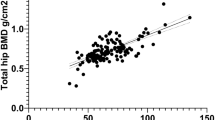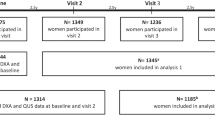Abstract:
The aim of this study was to assess a dry calcaneal quantitative ultrasound (QUS) device by examining: (i) short- and long-term precision; (ii) the ability of the ultrasound parameters to identify women with vertebral fractures; (iii) age- and menopause-related bone loss; (iv) applicability of the WHO criteria in scan interpretation. The study group consisted of 422 healthy women with no risk factors associated with osteoporosis (227 premenopausal and 195 postmenopausal) and 93 women with one or more vertebral fractures. All women had calcaneal QUS and bone mineral density (BMD) measurements of the lumbar spine and hip performed. Broadband ultrasound attenuation (BUA) and speed of sound (SOS) measurements in the heel were combined and expressed as estimated heel BMD. Short-term precision studies yielded coefficient of variations of 0.3% for SOS, 4% for BUA and 3.3% for estimated heel BMD. Standardized short-term precision values were approximately 0.2 SD. Long-term standardized precision errors ranged from 0.17 to 0.38 SD. All the QUS and BMD measurement parameters showed significant negative relationships with age in the postmenopausal group. Annual losses were 0.35 dB/MHz per year for BUA, 0.56 m/s per year for SOS and 0.002 g/cm2 per year for estimated heel BMD. All the QUS and BMD parameters were able to discriminate between healthy postmenopausal women and women with vertebral fracture. Age-adjusted odds ratios for each SD decline in QUS measurements were 3.63, 5.25 and 4.79 for BUA, SOS and estimated heel BMD respectively. Corresponding odds ratios for BMD at the lumbar spine, femoral neck and total hip were 2.39, 2.51 and 2.95 respectively. When the QUS and BMD parameters were expressed as T-scores, estimated heel BMD showed the least age-related decline, while femoral neck BMD displayed the greatest decrease with age. The mean T-score and prevalence of osteoporosis (T<−2.5) for a Caucasian woman aged 60–65 years were −1.35 and 21% respectively for the lumbar spine compared with −0.59 and 2% for estimated heel BMD. In conclusion, this study revealed that contact ultrasound can detect age- and menopause-related influences on bone status and was able to discriminate between healthy individuals and women with vertebral fracture. However, the widely accepted threshold of a T-score of less than −2.5 for the definition of osteoporosis may need modifying for the interpretation of QUS scans.
Similar content being viewed by others
Author information
Authors and Affiliations
Additional information
Received: 8 February 1999 / Accepted: 5 May 1999
Rights and permissions
About this article
Cite this article
Frost, M., Blake, G. & Fogelman, I. Contact Quantitative Ultrasound: An Evaluation of Precision, Fracture Discrimination, Age-Related Bone Loss and Applicability of the WHO Criteria. Osteoporos Int 10, 441–449 (1999). https://doi.org/10.1007/s001980050252
Issue Date:
DOI: https://doi.org/10.1007/s001980050252




